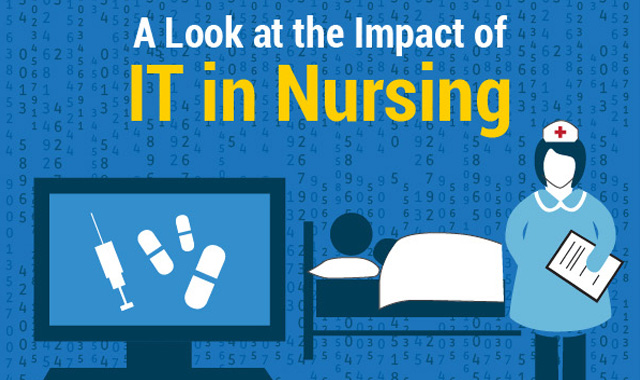The Nursing profession is in dire need of an IT upgrade. The way the nursing profession currently handles information is costing time, money, patient health and more importantly, lives. Creating an integrated health IT system will address these costs, as well as reducing errors among hospital staff and mistakes with prescriptions both when they are written and when patients obtain them.
To learn more checkout the following infographic, created by the Adventist University of Health Sciences Online RN to BSN program, that illustrates the need, benefit and impact of Health IT in nursing.

The Need for Health IT
Why does the U.S. Healthcare system need a technology update?
Reduction of Medical Errors
Medical errors contribute to 400,000 premature deaths each year. Of these, 190,000 are due to diagnostic errors, errors of omissions and failure to follow guidelines. The remaining 210,000 are due to preventable harm. Medical errors can be prevented by technological innovations such as Electronic Health Records, Electronic Medical Records and electronic prescriptions. Going further, these innovations will help to reduce Adverse Drug Effects (ADEs). It is estimated that over 800,000 preventable ADEs occurs each year in long-term care facilities alone. Another 530,000 occur among Medicare outpatients. ADEs is estimated to add $10,340 to the cost of a hospital stay.
Finally, technological innovation will help reduce preventable drug injuries. An estimated 380,000 – 450,000 occur annually, further driving up the cost of a hospital stay.
Reducing Health Care Cost
Three trillion dollars is spent annually on health care in the United States. This could be cut by around $100 billion by stopping the preventable deaths.
Inadequacy of Paper Documentation
The current documentation system, which relies on paper records, is outdated and, as a result of this, patients are often treated by multiple doctors and nurses, which involves multiple records in various locations. These records must be physically moved from place to place, which raises both the risk of the records being lost and the security of the records being compromised. Lastly, prescriptions are handwritten and often illegible.
Components of Health IT
Clinical Information System (CIS)
Clinical Data Repository (CDR)
Clinical Decision Support System (CDSS)
Electronic Health Records (EHR)
Electronic Medical Records (EMR)
Computerized Physician Order Entry (CPOE)
Electronic Medication Administration Record (eMAR)
Electronic Prescribing (eRx)
Mobile Devices
Cloud Computing
Telemedics
Assessing the Progress of Health IT
Health IT has been the focus of recent changes in the U.S. healthcare system and the transition to Electronic Medial Records (EMR) for healthcare providers is at the center of these efforts. While a requirement as part of the Affordable Care Act, many healthcare providers have yet to introduce an integrated health IT system. To date, what progress has been made?
HIMSS Analytics EMR Adoption Model
The EMR Adoption Model is used to score hospitals in the HIMSS Analytics Database on their progress in completing the seven steps to create a paperless patient record environment. These stages are: 1.Three major ancillary clinical systems are installed 2. These systems feed data to CDR 3. Required nursing/clinical documentation is integrated 4. CPOE for use by any clinician licensed to create orders is added to the current environment 5. The closed loop medication administration is fully implemented 6. Full physician documentation with structured templates and discrete data is implemented 7. The hospital no longer uses paper charts within its EMR environment.
As of second quarter 2014, 3.2% of hospitals are at stage 7.
HR Adoption
According to the Office of National Coordinator for Health Information Technology, hospital adoption of at least a basic EHR system has more than tripled, comprehensive adoption has increased six-fold and adoption of at least a basic EHR without clinician notes has more than tripled from 2009 to 2014.
While great progress has been made, the U.S. healthcare system is in dire need of major IT updates and a more integrated system. It will take years and billions of dollars, but the lives and money an integrated health system will save in the long run will be tremendous.






























